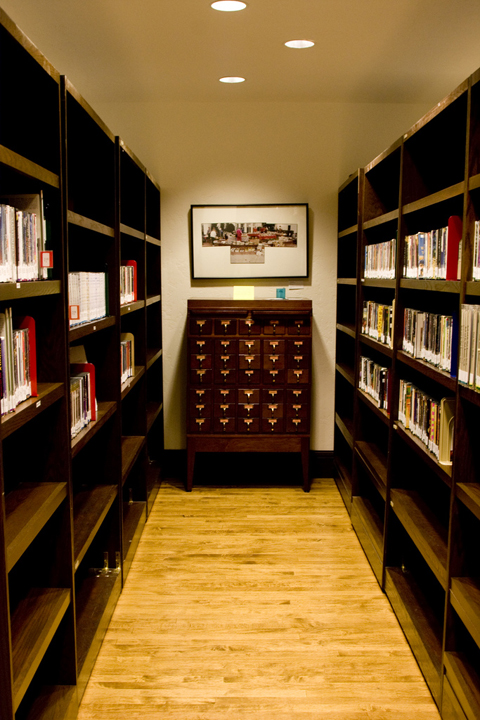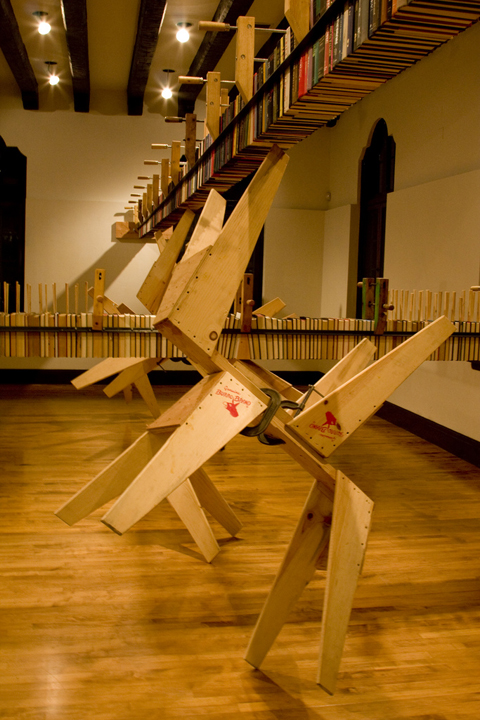Though nomadic in medium, the work of David Adey is consistent in concept and in the evident time and process behind it. A college professor at Point Loma Nazarene University, he works full-time as an artist between graduation and freshman orientation and this year his summer goal was to suspend a row of books between two walls with minimal support. Tests were conducted in PLNU’s Keller Gallery towards a final installation process, which was executed in a matter of days for the piece’s debut last week at La Jolla’s Athenaeum Library.
“John Henry” implements the traditional principles used in bridge design, with trapezoidal blocks pushing the books into an upward arch and thin wooden shims reciprocating the pressure downward. Everything used to guide the structure is visible and in a way mark the “backyard experiment” element of the process, which absorbed most weekday hours of 2009’s summer months. When I visited his studio in June, he had already survived a handful of “book explosions” in his first tests and had no sure idea of what would happen when he pulled the supports from the particular test he was assembling. The pioneer-like excitement of his expressions as he explained his discoveries was strong enough that I found myself curious about his progress all summer.
The finished work represents the human sense of purpose derived from working towards understanding and accomplishment, whether out of necessity or curiousity. Rather than laboring over a large body of work, time was spent learning the physics of his specific materials and developing a sure process of exercising them. He is an expert in a unique field and possesses an intimacy with books, clamps, sawhorses, and ratchet straps only available with long hours of study. At the opening, Adey could be seen casually spinning the cockeyed sawhorses like a double-bassist in a rockabilly band, a subtle indication of his unmatched familiarity with the materials. The following are answers to questions based on conversations that were overheard at the exhibition last week:
Photos by Chadwick Gantes
When did you come up with the idea for the piece?
I had been thinking about the idea in some form for a while but never took it any further than just thinking. When The Athenaeum first approached me to talk about a show, they were initially interested in some of my other work. After looking at the space a couple of times it seemed like the right time to pursue the idea. It was a last minute decision to pitch it to them so when we had our first meeting to discuss ideas for the show I didn’t have a sketch or anything. I remember waving my arms around a lot. They loved the idea and that was great at first, but on my way home I started getting pretty nervous. I had no idea how to do it or if it was even possible. Stephanie Scanga and Erica Torri took a pretty big risk since I had never done anything like this before. I found out later that they called Luis de Jesus after our meeting to see if he thought I was crazy but whatever he said convinced them to go ahead with it. I’m grateful to all of them for the opportunity.
When did you initially start working on tests and how long did it take you to perfect the installation process?
I did a really small test in my office at PLNU with my own books but it didn’t really work. I couldn’t do anything else until I had enough books so I started collecting right away. The Athenaeum invited me to come to their monthly Saturday book sales to take whatever didn’t sell, so I started bringing truck loads of books back to my studio. That went on for over a year and I started the first real tests last May.

What were your biggest obstacles in developing the design?
Too many and too specific to list. It was really a back yard engineering experiment. Every time I tried to fix a problem it would cause another one, so I felt like I was chasing it down all summer. The first couple of disasters were pretty depressing, but I tried to embrace the process and after a while it was actually pretty fun.
How did you land on the title and were there other ideas in the works?
Futility, pressure, spectacle, feats of strength, absurdity, faith, poetry, death. I never considered another title.
Music by Scott Wheeler of Cuckoo Chaos
Did you work on other art this summer or did John Henry take up the bulk of your time? Did you ever consider throwing in the towel on it?
I worked on a few other pieces but this took the bulk of my time and energy. I did the final test installation in Keller Gallery on the PLNU campus which I let stand for a month as a stress test. I was on vacation for a couple of weeks and my assistant Jenna Morrow was texting me updates almost daily to let me know if it was still standing. I never considered throwing in the towel.
Do you plan on working with the same materials and process on additional pieces or moving on to other ideas?
I don’t know for sure if I’ll use books again, but the ideas that lead to this piece are some of the same ideas I’ve been thinking about for almost 10 years. I know some people probably think this is a huge departure from my other work but it’s not that way for me at all. I’m working on a few new pieces right now that I’m really excited about that require some education and new skills. For me it’s always the ideas that carry from piece to piece, not always the material.

What's next?
When the Athenaeum show closes, I pack up the truck and take it up to Luis de Jesus Los Angeles in Bergamot Station, Santa Monica. Luis and Jay are putting so much into this new gallery and after seeing the space for the first time this week I’m blown away. The piece will be very different since the space is more of a blank slate. After that I’m looking forward to a summer in the studio and spending a lot of time at home with our new baby who’s due in May.
John Henry will be on display through April 3rd, visit The Athenaeum website for more information.